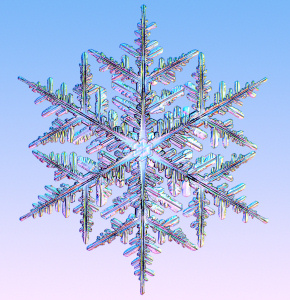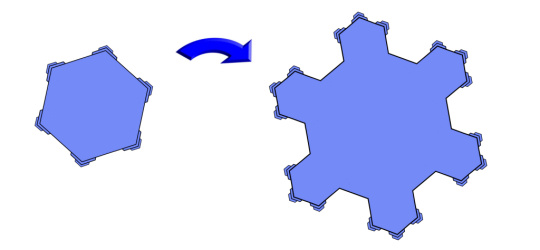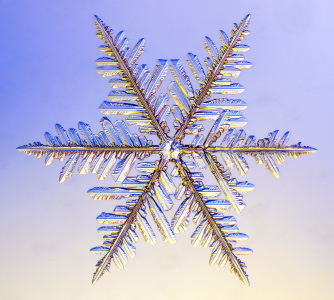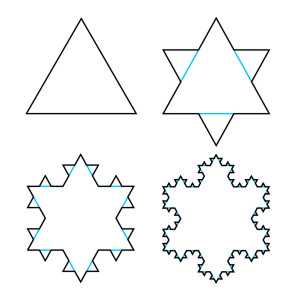|
|

Morphogenesis on Ice
The transformation that turns a faceted ice prism into an intricately branched stellar dendrite is an example of physical morphogenesis—the spontaneous creation of pattern and form by inanimate materials, the process by which order arises from chaos.
There
are plenty of other manifestations of physical morphogenesis you can
find around you, such as ripples on ponds, banded patterns on
snowdrifts and sand dunes, and even the billowing convection cells you
see in a bowl of hot miso soup. Of course, our favorite example is
always the snowflake—the quintessential example of physical
morphogenesis. |
|  The Origin of Branching The Origin of Branching
The
six corners of a snow crystal grow a bit faster because they stick out
farther into the humid air, causing branches to sprout. As the crystal
grows larger, the same effect causes sidebranches to sprout from the
faceted corners of each branch. This process is responsible for the
complex shapes of snow crystals.
Branching is an example of a growth instability.
The corners of a hexagonal plate stick out a bit, so they grow a bit
faster, causing them to stick out even farther, causing them to grow
even faster.
As a general rule, faceting dominates when snow crystals are small, or when they grow slowly. Larger, faster growing crystals become branched. |
| 
Chaos and Order
The
formation of sidebranches sometimes exhibits a chaotic behavior, as in
this fernlike stellar dendrite. When the ice growth is especially
hurried, the sidebranches are rather erratically spaced, with little
symmetry between the branches, or even between the two sides of a
single branch.
Chaos and order are both present during snowflake
growth, and this is what makes snowflake patterns so intriguing. By
itself, the branching instability brings chaos -- the unbridled
creation of structural complexity. Faceting, on the other hand, brings
order, as in the simple perfection of a hexagonal prism. Bring those
two forces together, however, and beautifully intricate, symmetrical
snowflakes result. |
|  Fractals Fractals
Branched constructions like snowflakes often exhibit fractal
patterns. The defining characteristic of a fractal snowflake is a
self-similar structure, where branches have sidebranches, which have
their own smaller sidebranches, and so on. The self-similar
construction on the right is called a Koch snowflake.
In fact,
real snowflakes are only slightly fractal. The first sidebranches
rarely have additional sidebranches, so calling the whole assembly
self-similar is a bit tenuous. Moreover, noting the fractal qualities
of a branched snowflake does not shine any light on its origin. The
branching instability is needed to explain why the branches and
sidebranches arise in the first place. |
|
|
|
